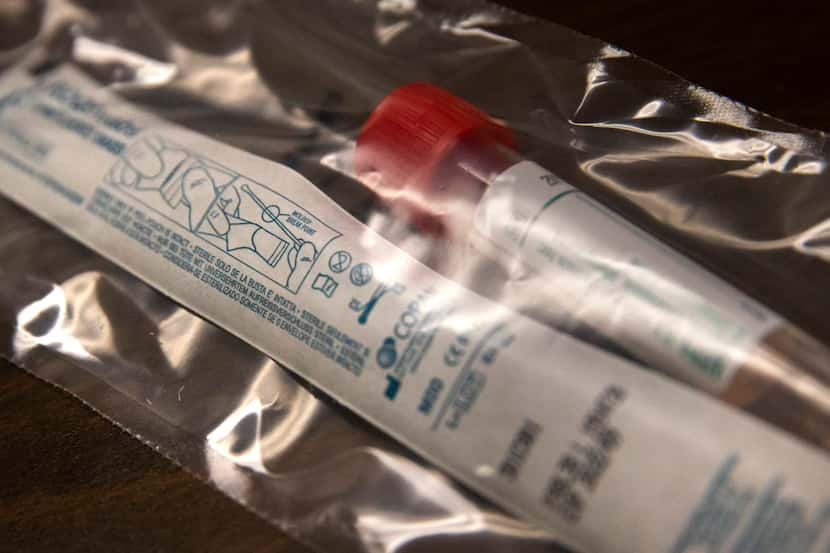The state’s health department introduced a new method for calculating coronavirus test positivity rates this month to help give a clearer picture of the COVID-19 outbreak across Texas.
But health experts say that even though the new method is the best way to measure the percentage of positive tests, the results will still have limitations.
In fact, the state’s coronavirus dashboard now shows three positivity rates: one calculated using a seven-day average based on the date COVID-19 tests were conducted, one using a seven-day average based on when lab results were reported to the state, and one using the state’s original way of calculating the rate.
The original way, which the state refers to as its legacy method, divided the seven-day average of new COVID-19 cases by the seven-day average of new coronavirus tests.
That method was regarded as reliable for many months, but state health officials said a backlog in the reporting system, and other delays identified in August, prompted them to reevaluate it.
The new calculations offer a more timely, accurate assessment of the pandemic, health officials say. They also include quality checks for each data point to ensure tests aren’t duplicated or added into the total when they shouldn’t be.
All three methods will be displayed on the dashboard for some time, but the state will rely primarily on the positivity rate calculated using the date tests were conducted.
The other two methods probably will be phased out, said Chris Van Deusen, a spokesman for the Texas Department of State Health Services.
“We wanted to leave the previous method up for the time being to provide some continuity and transparency and the ability to compare it with the rate by specimen collection date,” he said. “The test-reported date provides a measure of when public health receives lab results and was the other method we were considering as we evaluated possible changes.”
Still some limitations
Some health experts have expressed reservations about relying too much on the positivity rate because it’s dependent on testing criteria, which change frequently.
In Dallas County, for example, test sites at the beginning of the pandemic were only testing people who showed symptoms. But as the months passed, people were able to get tested if they didn’t have symptoms. This included essential workers and people who had attended protests against police brutality in May and June.
Those changes in standards make it difficult, if not impossible, to compare positivity rates accurately over time, experts say.
With the state’s latest calculations, the rate is likely to fluctuate as test results come in. And though the new method is the “preferred way to track the information,” lag times in reporting make it hard to use the rate to make real-time decisions, said Dr. John Carlo, former Dallas County medical director and CEO of Prism Health North Texas.
“There’s going to be a period of time where the data is not as accurate as we’d like it to be, and we want to know what that period of time is,” he said. “Is it four weeks, six weeks? Then that kind of helps you understand where you start looking.”
He said the further back researchers go on the curve, the more certain they can be that all the data are accounted for.
The new method confirms what health experts concluded from data such as hospitalizations in June and July. The state’s graph shows that based on the new method, the test positivity rate peaked July 7 and hospitalizations peaked July 22.
Carlo said that’s close to the span that health experts would predict between a high volume of positive tests and when people become sick enough to require hospitalization.
Jose-Miguel Yamal, an associate professor of biostatistics and data science at the University of Texas School of Public Health in Houston, said he’s been looking at 14-day averages of positive test rates to ensure the data are more stable.
He said the only way to determine how reporting delays will affect the state’s dashboard is to monitor the results over time.
“If positive tests, for example, are reported faster to the state than negative tests,” that could also cause the rate to fluctuate, he said. “I’m not sure if that’s what’s happening or if that’s going to happen — I think we’ll just have to wait and see. If there’s a bias there in what gets reported, then probably the last seven days may be a bit unstable. But we’ll see that as it kind of plays out over time.”


/cloudfront-us-east-1.images.arcpublishing.com/dmn/R4ZQGZRVQVGNC4NQXEUW6EDMDQ.jpg)
:no_upscale()/cloudfront-us-east-1.images.arcpublishing.com/dmn/33U7Q4NH5YEB2NHWWSAQUB77RQ.jpg)
:no_upscale()/cloudfront-us-east-1.images.arcpublishing.com/dmn/QZJPKXIVHUNAOPMYOTR4KWHXAU.jpg)
/cloudfront-us-east-1.images.arcpublishing.com/dmn/CLNOYLF5LE4U45ZWV5ALQV4WX4.jpg)
/cloudfront-us-east-1.images.arcpublishing.com/dmn/WQ2PADIFGVCITLLHLVMQ3GUQHM.jpg)